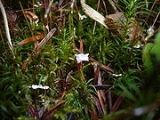
Cyphellostereum
Encyclopedia
Cyphellostereum is genus
of basidiolichen
s. Species produce white, somewhat cup-shaped fruit bodies
on a thin film of green on soil which is the thallus. All Cyphellostereum species have nonamyloid
spores and tissues, lack clamp connection
s, and also lack hymenial cystidia.
DNA research has shown that a common, north temperate species formerly known as Cyphellostereum laeve is not related to the type species
and belongs in a quite separate order
, the Hymenochaetales
. It has been renamed Muscinupta laevis.
); and Stereum
, in reference to the stipitate fan-shape or bracket shape (as in species of Stereum).
Genus
In biology, a genus is a low-level taxonomic rank used in the biological classification of living and fossil organisms, which is an example of definition by genus and differentia...
of basidiolichen
Basidiolichen
Basidiolichens are lichenized members of the Basidiomycota, a much smaller group of lichens than the far more common ascolichens in the Ascomycota. In arctic, alpine, and temperate forests, the most common basidiolichens are in the agaric genus Lichenomphalia and the clavarioid genus Multiclavula...
s. Species produce white, somewhat cup-shaped fruit bodies
Basidiocarp
In fungi, a basidiocarp, basidiome or basidioma , is the sporocarp of a basidiomycete, the multicellular structure on which the spore-producing hymenium is borne. Basidiocarps are characteristic of the hymenomycetes; rusts and smuts do not produce such structures...
on a thin film of green on soil which is the thallus. All Cyphellostereum species have nonamyloid
Amyloid (mycology)
In mycology the term amyloid refers to a crude chemical test using iodine in either Melzer's reagent or Lugol's solution, to produce a black to blue-black positive reaction. It is called amyloid because starch gives a similar reaction, and that reaction for starch is also called an amyloid reaction...
spores and tissues, lack clamp connection
Clamp connection
A clamp connection is a structure formed by growing hyphal cells of certain fungi. It is created to ensure each septum, or segment of hypha separated by crossed walls, receives a set of differing nuclei, which are obtained through mating of hyphae of differing sexual types...
s, and also lack hymenial cystidia.
DNA research has shown that a common, north temperate species formerly known as Cyphellostereum laeve is not related to the type species
Type species
In biological nomenclature, a type species is both a concept and a practical system which is used in the classification and nomenclature of animals and plants. The value of a "type species" lies in the fact that it makes clear what is meant by a particular genus name. A type species is the species...
and belongs in a quite separate order
Order (biology)
In scientific classification used in biology, the order is# a taxonomic rank used in the classification of organisms. Other well-known ranks are life, domain, kingdom, phylum, class, family, genus, and species, with order fitting in between class and family...
, the Hymenochaetales
Hymenochaetales
The Hymenochaetales are an order of fungi in the class Agaricomycetes. The order in its current sense is based on molecular research and not on any unifying morphological characteristics. According to one 2008 estimate, the Hymenochaetales contain around 600 species worldwide, mostly corticioid...
. It has been renamed Muscinupta laevis.
Etymology
The name Cyphellostereum combines two generic names: Cyphella in reference to the inverted cupulate form (like the genus CyphellaCyphella
Cyphella is a genus of fungi in the family Cyphellaceae. The genus contains two widely distributed species....
); and Stereum
Stereum
Stereum is type genus of the Stereaceae family of fungi, in the Russulales order. Until recently, the genus was classified in the Corticiaceae family, of the Corticiales order. However, it was given its own family as a result of the split-up of the Corticiales. Common names for species of this...
, in reference to the stipitate fan-shape or bracket shape (as in species of Stereum).

